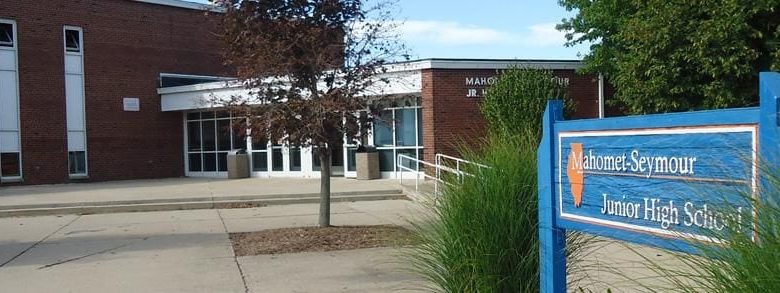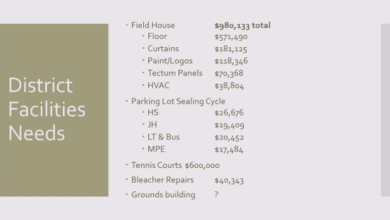Mahomet-Seymour to ask taxpayers for $59.4 million for new junior high in Nov. midterm, facility survey included


The Mahomet-Seymour School District is going back to constituents on Nov. 8 to ask for $59.4 million to build a new junior high school on 30-plus acres south of the current location of Middletown Prairie Elementary on the east side of the Village of Mahomet.
The referendum comes back around after a $97.9 million referendum was voted down on June 28. The question failed with a final tally of 3,511 (67.20%) opposed and 1,714 (32.80%) in favor of the plan that guaranteed a junior high and bus barn, while also eyeing additions at Middletown Prairie, Lincoln Trail and Mahomet-Seymour High School that included classrooms, athletic field updates and creative spaces, such as new specials classrooms at the lower levels and an auditorium at the high school, should enough funds be available.
In an early August study session the board of education reviewed results from a survey that was emailed to district parents. The survey was designed by Creative Entourage, a marketing company hired to help pass the $97.9 million referendum.
Through BLDD Architects, Creative Entourage did receive dollars for its help with the Bulldog Blueprint initiative. Superintendent Kenny Lee said he does not expect another contract like the one that would have paid $40,000 to BLDD and Creative Entourage if the referendum passed in the upcoming Nov. 8 election.
Creative Entourage also designed an earlier survey that gave a nod to the Bulldog Blueprint team’s recommendation for the $97.9 million referendum. Results of the survey showed that its participants supported the question, although the support declined as participants answered the questions presented in the survey.
Board member Colleen Schultz, who is also an Economics Professor at the University of Illinois and teaches students how to analyze data from surveys, voiced her concern with the bias of the questions in the first survey, and repeated that concern even before the survey was sent out to constituents.
Over the last two years, Schultz has also voiced her concern with how the district listens or fails to listen to its constituents on many issues, including the next steps in planning for facilities.
As the board of education approached the vote for the Nov. 8 referendum measure, Schultz asked the board to, once again, pause and create opportunities for open community feedback. Many on the board of education believe that opportunity happened with the Bulldog Blueprint community meetings. Still, 432 of the 936 respondents in the July 2022 survey offered their ongoing opinions about what the district needs to consider to win their vote on any future referendum.
Some of those responses included feelings that the board was not listening to the community.
Despite calls to take that time, board member Jeremy Henrichs made the motion for the $59.4 million question after hours of discussion, stating that something needs to be done to create more classroom space for the junior high.
Earlier in the meeting, Henrichs stated that he did not believe any ask will be approved in November.
“I’m pretty pessimistic about the whole thing,” he said. “I kind of feel like it doesn’t matter what we put on a ballot, it’s probably not going to pass this November. You know, for whatever reason, the circumstances of the economy and people’s general perception of public education right now. You name it, but I just don’t get a sense it’s got a real good chance of anything passing.”
Henrichs continued that that position is frustrating because Mahomet-Seymour Junior High principal Nathan Mills presented information early in the Aug. 15 meeting that some classrooms were doubled up. Henrichs said that the current environment impacts how students learn.
Board member Sunny McMurry said that people probably won’t change their vote until they feel the pain of the current situation. She added that teachers are helping to make the current situation of having classes of over 30 kids at the junior high bearable.
McMurry also doesn’t believe that the referendum will pass until all seven board members support the referendum question.
That did not happen when Henrichs posed the question. Henrichs, McMurry and fellow board members Justin Lamb and Max McComb voted in favor of the measure while Schultz and Meghan Hennesy voted against it.
Schultz and Hennesy agree something needs to be done to address overcrowding of classrooms and facilities, but they have paused on supporting plans put forward thus far because they believe the means of capturing community opinions are disingenuous and have laid out how the asks are either too expensive or don’t address long-term growth within the district.
Hennesy and Schultz also believe that in just building a junior high, the district is not addressing overcrowding at Lincoln Trail Elementary and Middletown Prairie Elementary. Recent anecdotal reports also have accounted for large class sizes at Mahomet-Seymour High School.
After a decade of knowing Mahomet-Seymour Junior High was overcrowded and in need of maintenance and extra space, Schultz and Hennesy said they believe this lack of long-term vision has backed voters into a corner; and not addressing those needs in the other buildings at this time will lead constituents into the same need and corner in the future.
Superintendent Kenny Lee and BLDD presented the board of education with several options to consider in the middle of August.
In Phase I, Option “A” included the new junior high on the Middletown Prairie property for $59.4 million. Option “B” included a new 7-8 building on the Middletown Prairie property for $48.4 million, renovating the current junior high building to house grades 5-6 for $9.9 million and keeping grades 3-4 at Lincoln Trail. Option “C” included a new 3-4 building on the Middletown Prairie property for $30.8 million, renovating the current junior for grades 7-8 for $20.9 million and using Lincoln Trail for grades 5-6.
The district and board members agree that most likely two buildings will need to be added to the district to accommodate growth in the future. Lee suggested that the district may want to consider two elementary buildings that house grades K-5 while other board members suggested buildings that house students in grades 2-5, keeping Pre-K to 1st grade together.
BLDD Architect Damien Schlitt added that he was hesitant about having students go to a different building every two years because they don’t receive continuity over the years. He and Lee also discussed the cost of duplicate staff and services, such as food, custodial and social workers, along with the additional costs of administrative staff.
These considerations are part of what Schultz and Hennesy would like the district to define and outline for voters prior to asking them to contribute additional tax dollars.
Schultz offered suggestions on a few immediate fixes that would get more classrooms in a year or two, rather than a few years down the line, as would be the case with building a new building. With current sales tax dollars or in asking voters in Nov. for a smaller amount of money, the district could 10-20 classrooms onto Middletown Prairie, Lincoln Trail and/or Mahomet-Seymour Junior high, respectively.
She added that would provide relief right now while the district decides if it would like to move in the direction of several elementary schools or even a new high school, which would give room for grades to spread out over Mahomet-Seymour’s current facilities.
A new high school would cost taxpayers around $80 million, pre-inflation, without adding the bells and whistles. The district would also have to acquire land in order to build a new high school. The option, though, is something that some taxpayers say they would support if it was accompanied by a long-range facilities plan.
This is the kind of plan Hennesy and Schultz want to develop.
Hennesy said that in order for taxpayers to vote yes on future referendums, “we have to show them that we’ve thought through the utilization of every single square foot that we own currently, how that’s going to look and that we’re willing to do the hard work to make that happen.
“And it doesn’t have to be forever, but it has to be for enough time, combined with a vision that is longer term that people say okay, I’m willing to give you my money. If we cannot do that they are not going to give us that money.”
It was estimated that a homeowner in Mahomet-Seymour with a home valued at $300,000 (the median home value) would have paid an additional $1053 in taxes annually for the $97.9 million referendum. That was based on 3.5-percent interest rate.
It is now estimated that a homeowner in Mahomet-Seymour with a home valued at $300,000 (the median home value) would pay an additional $504 in taxes annually if the $59.4 million referendum passes in November. That is based on a 4.6-percent interest rate, which is a little higher than the current bond rate, 4.25-percent, according to Superintendent Lee.
The board also briefly discussed a “pared down” junior high school with grades 7-8 at $43 million, which would have added an additional $242 to the tax bill of a home assessed at $300,000. Board members also considered using the $17.5 million in sales tax dollars that the district currently has, but felt that would extend their means a little too much.
McComb believed that the reason the referendum failed, even after the survey results said the community supported the $97.9 million question, was because gas prices skyrocketed, just as inflation also affected prices of food and other common goods.
BLDD Architect Damien Schlitt said that since June prices in the construction industry have started to stabilize a bit, but he does not believe that they will return to pre-pandemic prices. The Fed is also expected to continue to raise interest rates to help stabilize inflation.
Lee suggested that a Nov. 8 question would give voters the opportunity to consider a new option before the April 2023 election that will include four school board seats. Lee fears that if a question were on the April ballot, school board candidates might run on one issue. If it were not on the April ballot, it would be 2024 before the next opportunity comes.
Schultz still believed that the board should pause to listen to the community. She read all the responses from the July survey, summarizing them into 97 different ideas, and 10 different categories.
Some of the consistent themes were concerns about residential growth within the Village of Mahomet; wasteful proposal with turf and performing arts center; lack of detailed plan; that the board of education does not listen to ideas; there was too much campaigning; past poor decisions and that money is not well spent; lack of curriculum; short-sighted priorities and teacher pay, to name a few.
The results of the survey, obtained via FOIA, are below this article.
McComb noted that there were people who did also vote in favor of the referendum, and that there were also about 400 people who did not write a response in the provided space.
Schultz, though, noted that the questions asked people about their perceptions of why people voted the way they did instead of collecting data on if someone voted, why that person voted the way they did and what they would support in the future.
She suggested board listening sessions to overcome the perception that the board is moving towards a predetermined outcome of a junior high on the property on the east side of Mahomet. Many of Schultz’s suggestions were met with reasons why they could not happen, as were suggestions presented by other board members throughout the two sessions.
The Mahomet Daily has developed a survey for community members who want to share their opinions and outlook for facilities in the Mahomet-Seymour community. This survey will be open until Sept. 9 at 5 p.m. The results will be posted on Sept. 12 before the Mahomet-Seymour board meeting. The board indicated that it would discuss what to do moving forward should the Nov. 8 referendum fail.
Bond Referendum Survey Results from the Mahomet-Seymour School District FOIA response (download)





I will vote NO until the village and school district come together and put a stop to this unneeded growth. The district is in dire straights and the village is on the verge of approving 22 single family homes at Tin Cup. I figure that will add between 25 and 40 students to our already over crowded schools. Just stop, take a breather, work together and maybe then you will get residents on board.
Add business not new homes so sc schools won’t be crowded.